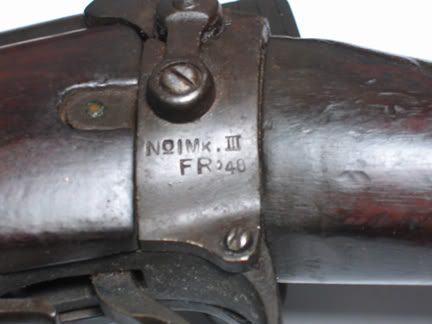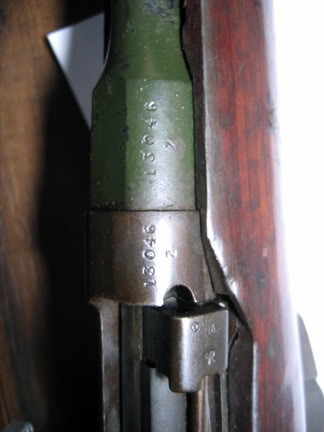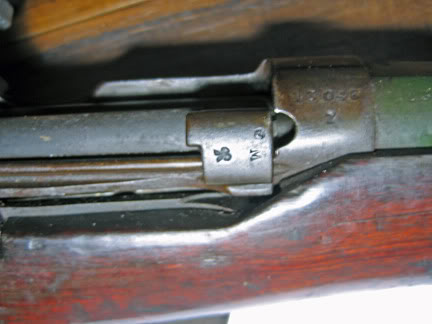-
FREE MEMBER
NO Posting or PM's Allowed

-
11-06-2009 09:23 PM
# ADS
Friends and Sponsors

-
The FR 48 indicates it was completely rebuilt in 1948 - whatever marking that would identify it before that were removed. Does the barrel have a date on the left side of the knox form?
Last edited by Amatikulu; 11-08-2009 at 07:21 AM.
Reason: next time I'll wear glasses
-
-
Advisory Panel


1948 rebuild of - probably - an English 1914-16 rifle. Show us the right butt socket markings, and anything on the left side of the barrel.
-
-
FREE MEMBER
NO Posting or PM's Allowed

I'll look at the barrel again but I don't recall a barrel date. There are absolutely no markings on the butt socket on the bolt handle side ... none. Doesn't even look 'scrubbed', although it must have been.
There are GRI marks on receiver and barrel.
 [/IMG]
[/IMG]
I'll take more pics later.
-
FREE MEMBER
NO Posting or PM's Allowed

Still no extra pics but, definitely no date and the butt socket, on the bolt side shows no signs of scrubbing. Absolutely smooth. Usually you can see evidence of the scrub.
What does the serial number tell us? 'Z' after the 5 digit number. Did I read somewhere that Ishapore started the letters backwards on one of their FR series? In the 1960's maybe?
-
Legacy Member

You are dead right about the serial number prefixes running backwards for these second type FR rifles----I have an "FR '49" rifle with an "X" prefix.
The smooth right side of the buttsocket is normal for these rifles----but do I spy a British "GR" proof on the receiver ring just below the Indian "GRI" proof?
"GR" proof on the receiver ring just below the Indian "GRI" proof?
If so, that's more origin information than I've ever seen left on an FR.
-----krinko
-
-
FREE MEMBER
NO Posting or PM's Allowed

-
Legacy Member

The C.A.I. means Centrury Arms International. They are notorious for assembling rifles out of parts bins with zero QC. No headspace check to ensure the rifle is safe to shoot. Check the headspace before you do shoot it.
Go here for good info(especially markings).
The Lee-Enfield Rifle
Spelling and Grammar count!
-
-
Legacy Member

"The C.A.I. means Centrury Arms International. They are notorious for assembling rifles out of parts bins with zero QC. No headspace check to ensure the rifle is safe to shoot."
OHare, is that you?
-----krinko
-
-
Just another little point of interest and that's the kakhi paint undernath the woodwork of these rifles and Brens from not only India but elsewhere too. Early on in the war it was quickly established out in the tropics that the blueing process known to Armourers as 'browning' (don't ask me why, I haven't got a clue.....) and known chemically as 'rust blueing' or 'controlled corrosion' was at best, useless at protecting the steel or as a darkening process. It was also very time consuming too. So a solution was sought. In the meantime the process was abandoned everywhere outside the Ordnance factories and painting was approved. Just how dire the process was was quite clear with the BSA No5 rifles in Malaya and Borneo where the humidity and salt water laden silt would destroy the factory finish as soon as it got a sniff of it. Once rust had formed, it attacked its way into the wood too. We have the actual paint code and formula somewhere..........
The nett result was that by 1944, Enfield started the first beadblasted finish, phosphated and over-painting with the spirit based oven bake paint finish that we have today and never looked back. There was a cut-off date for Enfield revolvers that was to follow the Mk3 Brens but I have seen nothing more. Quite clearly Fazakerley followed soon afterwards as can be seen on the post was rifles.
Anyway, that's the story of the kakhi paint
Incidentally, what finish is present underneath the layers and layers and layers of gloss paint found on the Ishapore rifles? Any ideas
-


















 Register To Reply
Register To Reply









 [/IMG]
[/IMG]




